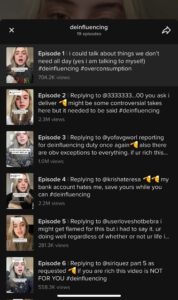De-influencing is a trend where people on TikTok make videos about how some products that have gone viral are not needed or worth the price. Within this trend, creators urge their viewers to actually think about the purchases they’re making and to not allow TikTok to force them to buy something so quickly. I think that it’s the best trend to ever surface on the app.
The first time I came across a de-influencing video was when TikTokker Michelle Skidelsky, who has around 86k followers, made her very first video about it. She now has a series on everything she believes “you don’t need.”
She starts these videos off by saying how she has a “spending problem” and wants to “cut back on overconsumption” and advises her followers to do so as well. In her first de-influencing video, she states that no one needs a perfume collection because they’re expensive, they expire and it’s nice to have a signature scent.

“This may sound controversial, but I don’t think you need multiple sets of fancy loungewear sets,” Skidelsky said in one of her de-influencing videos.
According to Jordan Greene, a magazine journalist at Today, the de-influencing hashtag has over 76 million views on TikTok and is gaining a lot of popularity. And stated in an article written in Marketing Dive News, 44% of Gen Z’s purchases are based on recommendations from influencers, and 26% of the general population have bought something suggested by an influencer.
Now, I am guilty of partaking in buying random things I see on TikTok because of how good and necessary they seem to be. However, I have never been one to go out and buy everything. Though this may not relate entirely to me, I know that so many people buy anything just because they saw it on TikTok.
Let’s first talk about how quickly things fly off the shelves when it goes viral on this app. A more recent and specific example of this is when a girl posted a video about her father’s book that’s been out for 11 years but never sold very well. Her video blew up and so did the book. The father’s book currently sits at #2 on Amazon’s most sold list and has spent the past two weeks on the top 20 list.
Though this is a positive instance of how TikTok can help some people, it also shows the influence it has on its users. The struggle with trends on this app is that users encourage overconsumption and overspending either to go viral or stay viral and become an influencer.
Influencing new “must haves” makes TikTok users feel pressured into buying everything they see and feeling like they need to keep up with all of the new trends. Most TikTokers complain that the app is the reason they don’t have any money. According to World Today News, this trend of de-influencing helps users watch their spending habits.
“Get ready with me’s” or “hauls” are the videos that get people to beg creators to share where they got every clothing item or every makeup product. If creators don’t do this, they get accused of “gatekeeping,” which is the act of withholding information of a product, good or service. In the TikTok community, “gatekeeping” is frowned upon, and no one likes a gatekeeper. So everyone shares where they get everything, and that leads to more people buying things they don’t need.
This is why people have a ton of different makeup products, an overfilled closet of clothes, all the same housing decor and only a couple dollars to their name. Which brings me to why de-influencing benefits everyone.
The trend encourages viewers to stop buying things just because they’re trending and calls out influencer’s credibility. It talks people out of buying a surplus of products and items when they have enough just because, and it puts a need versus a want into perspective. Finally, the questions of whether the product is really worth the money and if it’s really needed are being asked.
When I scroll on TikTok, I eventually leave the app feeling like I don’t have enough and I need more. I’ll tell you, it’s not a great feeling. Seeing the occasional de-influencing video makes me feel grounded, practical and better about the things I don’t have and the things I have stupidly bought.
Almost every makeup video I see, I end up saving and then writing in my notes the products I feel like I need. Don’t get me wrong, I have tons of blush and mascara, but I feel like I need another because of how flawless that creator made the product look.
A lot of people are more impulsive with their purchases and will go buy an item immediately after they see a video about it. If they see enough of these de-influencing videos, I think it’ll teach them to think about it first.
TikTok has made it okay to buy something as soon as possible regardless of the reason, and now with this trend of de-influencing, TikTok is making it okay to stop and think rationally about it.
